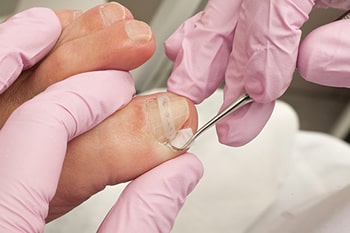Ingrown Toenails
Our podiatrist treats ingrown toenails in the areas of Los Angeles, CA 90049, and Encino, CA 91316. Call our offices today: Brentwood, Los Angeles at (310) 442-1975; Encino at (818) 798-1919 if you are dealing with ingrown toenails.

What is it?
Ingrown toenails, also known as onychocryptosis occurs when the nail plate has grown into the sides of the nail with or without an infection. The skin becomes irritated when the nail digs into the nail borders and can cause pain, redness, swelling and warmth to the toe (paronychia). They can occur in patients of all ages. An infection occurs in the area because an ingrown causes a break in the skin allowing bacteria to enter. At times a pus pocket can be present under the skin. With chronic ingrown toenails, overgrown tissue develops along the nail fold causing repetitive wound irritation and bleeding. Ingrown toenails can be prevented by trimming toenails straight across with no rounded corners, ensuring that shoes and socks are not too tight and keeping feet clean at all times.
What causes an ingrown nail?
Ingrown toenails are caused by multiple factors. The most common cause of ingrown toenails is improperly cutting the nails. When the nails are cut too short or at an angle the skin next to the nail is likely to fold over the nail. In many people ingrown nails are a result of genetics. Trauma such as stubbing a toe, having an object fall on your toe, physical activities that cause constant pressure on the toes and improperly sized footwear also can cause ingrown nails. Patients with fungal infections are also prone to ingrown toenails. Some patients are prone to ingrown nails if they are severely curved or thickened.
Ingrown nail treatment
Treatment involves education on proper nail trimming techniques such as cutting the nails straight across and not cutting them too short. If the case is mild and just beginning and the patient does not have any signs of infection or any at risk medical conditions than initial treatment can be safely performed at home with warm water Epsom salt soaks. It is not recommended to repeatedly cut the nail as the problem may worsen. If your symptoms do not improve, it is time to see a specialist. If an ingrown toenail is infected no amount of antibiotic will cure it until the offending nail border is satisfactorily removed.
- Partial nail avulsion procedure- It is a minor surgical procedure that is performed in the office using local anesthestic. The doctor removes part of the nail’s side border from the root. Any pus or granulation tissue is removed. Following the procedure a light bandage is applied and normal activity will be resumed the following day. There is typically minimal pain after the procedure.
Temporary removal of the offending border is generally recommended in a first-time case of ingrown toenail, while chronic ingrown toenails are best treated with either a chemical or surgical matrixectomy.
- Partial matrixectomy procedure- this procedure is very similar to a partial nail avulsion with the addition of a specialized acid called Phenol which is used over the root of the nail to kill the root cells. The area is then washed with alcohol to dilute the phenol. The aftercare is the same as for the nail avulsion. A chemical matrixectomy is not performed in the presence of an infection and is recommended that the patient undergo only an avulsion of the offending border.
- Surgical matrixectomy- In rare cases where a phenol matrixectomy was not successful a surgical excision of the nail root may be required. The procedure is performed in the operating room with local and IV sedation. The offending nail is removed and the matrix of the nail is then completely removed in the affected area. Stitches are required and will be removed 2 weeks after the procedure. The patient walks in a special shoe until the stitches are removed.
